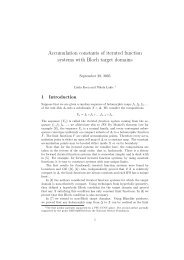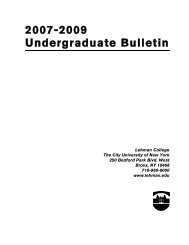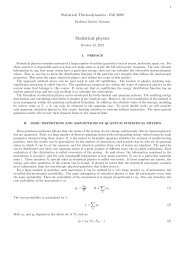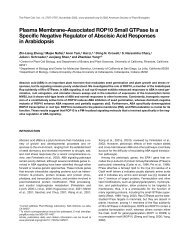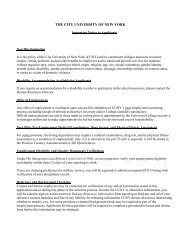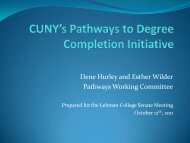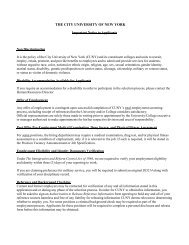Create successful ePaper yourself
Turn your PDF publications into a flip-book with our unique Google optimized e-Paper software.
“I’ve worked here for forty-six years. I started on September 28,<br />
1964. It’s a long time. But I enjoyed working here. The campus<br />
was really beautiful in those days. It was all green. There were just<br />
those four buildings. Everything else was green, like a big ballpark.<br />
Students could just sit on the lawn anywhere and do their homework<br />
or sit on a bench. There were benches everywhere. Back<br />
then, they had more tennis courts. They were beautiful. I used to<br />
take care of them. It was a two-person job, but I used to do it by<br />
myself. It was good for the students. They could play tennis and<br />
get some exercise. It was<br />
good for them. You can’t<br />
have your nose in a book<br />
all the time, can you?”<br />
— John “Johnny” Piparo,<br />
a member of both the<br />
Hunter and <strong>Lehman</strong><br />
Buildings and Grounds staff<br />
Interested in learning more about campus history and events planned<br />
for the Eightieth Anniversary Celebration? Would you like to<br />
contribute your own memories of the campus?<br />
Visit www.lehman.edu/80th.<br />
Do you have photos, programs, or other artifacts you would like the<br />
<strong>College</strong> to preserve? Email janet.munch@lehman.cuny.edu.<br />
Students of the Fifties can remember<br />
traditions like freshman hazing—in<br />
1953, 900 of them dressed as “space<br />
cadets” for a day, wearing helmets,<br />
goggles, propeller beanies, and flying<br />
capes. There was a lively theatre program,<br />
several varsity sports teams, blood drives,<br />
annual field days complete with a parade of floats, fashion shows<br />
for the March of Dimes and other worthy causes, fund-raising<br />
drives for victims of disasters, a campus carnival complete with the<br />
crowning of a Carnival Queen, and even a faculty football team.<br />
The 1960s<br />
Ce<br />
C<br />
• •<br />
For the students of the Sixties, social issues—and the threat of<br />
war—became intertwined with their years on the campus. “Within<br />
the confines of our world,” wrote the editors of one yearbook at<br />
that time, “political and social events paralleled closely those of the<br />
world around us. We were the generation of the peace-marchers<br />
to Washington and the Freedom-riders to the South. We were the<br />
generation that lived with the threat of the draft ever closer.” Those<br />
concerns gave rise to both protest and action, as sociology majors<br />
volunteered in Harlem, biology majors turned to cancer research,<br />
education minors worked with young people, and art majors<br />
painted holiday murals at a local hospital.<br />
The change underway in the larger society also resonated within<br />
the <strong>College</strong> structure. By the mid-1960s, Hunter was looking to<br />
consolidate its facilities in Manhattan, and a 1966 report revealed<br />
that some viewed the Bronx campus “as the colonial province of<br />
the Mother Country.” Within the year, Hunter decided to vacate<br />
the campus, and the Board of Higher Education voted to create<br />
an independent four-year college, which would be named after<br />
Herbert H. <strong>Lehman</strong>, the four-term governor of New York, former<br />
Director General of the United Nations Relief and Rehabilitation<br />
Administration, two-term U.S. Senator, and passionate advocate for<br />
human rights.<br />
On<br />
O<br />
el<br />
Leh<br />
Le<br />
L<br />
le<br />
hma<br />
hm<br />
ebr<br />
eb<br />
an’s Hi<br />
an<br />
rat<br />
ra<br />
in<br />
ti<br />
ng<br />
H<br />
s<br />
Hi<br />
His<br />
s<br />
80<br />
8<br />
80<br />
to<br />
st<br />
Ye<br />
Y<br />
ri<br />
tor<br />
ea<br />
amp<br />
am<br />
Ca<br />
C<br />
ric<br />
ar<br />
rs<br />
pus<br />
pu<br />
Their decision to attend Hunter-in-the-Bronx was a practical<br />
matter. “Neither of us came from wealthy backgrounds,” he admits.<br />
“My father was a plumber in the South Bronx, and this was before<br />
plumbers made brain-surgeon type money. We made our decision<br />
based on the quality of the education we would receive, the proximity<br />
to our homes, and affordability.”<br />
“Let’s be honest,” he continues, “in terms of colleges there weren’t<br />
a lot of options on the table. And frankly, where else could you have<br />
gotten such a quality education at that time for $24 a semester?”<br />
Both made the most of their time on the campus. Mrs. Cooperman<br />
belonged to a House Plan, a sorority-type of organization for female<br />
students; Mr. Cooperman belonged to a fraternity. Both fondly<br />
remember Student Hall (now the Music Building), where they would<br />
have lunch with friends and play cards in between classes.<br />
It wasn’t all fun and games, however. “We were part of the generation<br />
that worked very hard to succeed so that we could do better<br />
than our parents,” says Mrs. Cooperman, who earned a B.A. in<br />
history at Hunter. “We all really wanted to succeed in life.”<br />
Like a lot of New York City natives, they were beguiled by the open<br />
green spaces of the campus. “I remember the North Lawn,” says<br />
Mr. Cooperman, who received his B.A. in chemistry before switching<br />
gears and going into business. “You could read and sit on the lawn<br />
and do your homework. It was beautiful, all that open air.”<br />
Knowing a thing or two about investments, Mr. Cooperman laughs<br />
as he thinks back at the education that both he and his wife<br />
received here in the Bronx and how little it cost. “We would have<br />
strikes and complain that we had to pay $24,” he notes, “but we<br />
didn’t know how good we had it.”<br />
<strong>Lehman</strong> Today/<strong>Spring</strong> <strong>2011</strong> 25



